OUR HISTORY
1970s - Origins and Foundation
The Stained Glass Museum was founded in 1972 to rescue stained glass windows under threat from destruction. Many of the stained glass panels and windows in the collection were originally installed in Anglican churches which had been closed and made redundant. Some of these buildings were demolished and others were converted for alternative use. In several cases, significant stained glass windows were rescued from the building prior to demolition or modification.
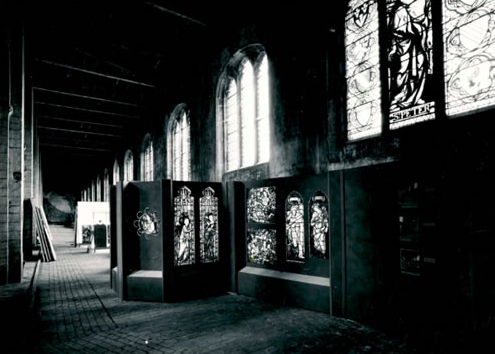
Under the Chairmanship of Sir Trenchard Cox (1905–1995), former Director of the Victoria and Albert Museum, leading experts were gathered to set up a Steering Committee to rescue of some of the finest windows available from redundant churches. Between 1973 and 1981 the collection of rescued windows grew under the curatorial guidance of Martin Harrison, an emerging expert on Victorian stained glass.
With the help of Revd Peter Moore (1924-2000), a Residentiary Canon at Ely Cathedral 1967-74, plans were made for a public display of the museum’s stained glass within Ely Cathedral. The Stained Glass Museum Trust was formally registered as a charity in 1977.
On 30 March 1979, The Stained Glass Museum first opened to the public in the north triforium of Ely Cathedral. At this time, the museum was only open during the summer, from April through to October, and admission was 50p (25p for students)! Just over 8,000 visitors visited during the museum’s first season.

Because of its close association with Ely Cathedral and the fact that many founder trustees were associated with the Anglican church, most of the stained glass windows rescued in these decades came from redundant Anglican churches. but windows were also occasionally rescued from Roman Catholic, Presbyterian and Unitarian churches as well as public buildings closing at the hands of town planners.
Acquisition highlight: Hadzor ‘Life of the Virgin’ (1976.4) This window is widely recognised as one of the finest examples of English 14th-century glass-painting, illustrating the elegance and sophistication of the 'Decorated' gothic style. Designed by an English Artist from the West Midlands in c.1340, the glass was heavily restored by John Hardman and Company in 1866. The glass was removed from the Church of St John the Baptist, Hadzor, when the building was deconsecrated in the 1970s. It came to the museum in 1976.
1980s - Development
A little more than a year after opening to the public, the museum welcomed its first royal visitor. On 15 May 1980 HRH Princess Margaret was shown around the museum by Trustee Michael Archer (1936-2022), Assistant Keeper in the Department of Ceramics at the Victoria and Albert Museum and the museum Curator Martin Harrison.
Princess Margaret’s royal visit and the accompanying publicity helped increase the museum’s visitors by 60% in its second year. In fact, repairs had to be made to the floor tiles in the north triforium which were being damaged by the footfall! In the same year the museum entrance fee increased from 50p to 70p, and a 30p entry charge for children was introduced.
Although rescued glass dominated the museum’s public displays, in the 1980s the museum began to enhance representation in the gallery by borrowing significant windows from other collections. A large window discovered in the basement of Buckingham Palace was first loaned from the Royal Collection in this decade. From the outset, the museum also showcased the work of contemporary stained glass artists. In 1981 the museum exhibited three prize winners’ panels from a 1981 competition organised by Hartley Wood, a leading glassmaking company based in Sunderland, in conjunction with the British Society of Master Glass Painters (BSMGP).
Within just ten years, the museum had amassed a large collection of stained glass, and the rate of church closures remained high with large numbers of stained glass windows with uncertain futures and potentially in need of a new home. In 1982 the Worshipful Company of Glaziers and Painters of Glass founded the London Stained Glass Repository, taking over the key role of rescuing and rehoming stained glass, particularly from churches, enabling the museum to be more selective in it acquisition criteria, as appropriate for a specialist museum collection.
Acquisition highlight: In 1982, the museum acquired the largest, complete window in our collection. Christ in Glory (1982.16) was designed by Henry Gustave Hiller and made in the Manchester-based studio of Reuben Bennett in 1904 for the east window of St Paul's in New Cross Manchester. The church was declared redundant in 1978 and demolished between 1984-1985 to make way for Manchester’s urban expansion.
1990s – Accreditation and Relocation
A number of changes in the 1990s saw the museum gradually take on the shape we recognise today. It was also in this decade that a major 25th Anniversary Appeal was launched to rebuild the Museum in the south triforium of Ely Cathedral.
In 1990 The Museum was awarded full registration with the Museums and Galleries Commission and began to open throughout the year in 1992. Extended opening hours, exhibitions and other events including the introduction of talks saw the museum’s visitor numbers increase significantly in this decade.

The museum in the north triforium was attracting more and more visitors, but only a single staircase provided access in and out of the museum. Volunteers working in the museum at that time recall undertaking annual fire escape training via a hammock and a winch over the side of the triforium down to the nave! Concerns following a health and safety inspection and the need for a secondary fire exit, led to a major project to oversee the museum’s relocation from the north to the south triforium of Ely Cathedral, where a secondary staircase could provide an alternative fire exit.
In July 1997 a major 25th Anniversary Appeal was launched, and King Charles III, then Prince of Wales, agreed to become Patron. The fundraising campaign lasted from 1997 until 1999 and raised over £600,000. The big move saw a bridge constructed across the Cathedral nave, to enable the museum’s collection to be carried by hand from the north to the south triforium. This was an enormous task carried out in spring 1997 thanks to the help of employees of several leading stained glass studios, and the able assistance of students at the stained glass department of Swansea Institute of Higher Education.
At the same time as the fundraising appeal to move the museum was going on, the museum continued to collect key examples of stained glass and to develop its events and outreach programme. In April 1999 the museum held its first touring Study Weekend, as well as its first glass painting and glazing workshops. In 1999 the museum also joined the world wide web for the first time launching its first website.
Major Acquisitions: Harry Clarke’s 1927 St Wilfrid and St John Berchmans (1998.2) was purchased by the museum at the Irish Sale at Christie’s auction house in 1988. Typical of Harry Clarke's style, the figures are elegant and attenuated, ornately clothed and set against a rich background. The panel was acquired thanks to grant-funding from the National Art Collections Fund and the V&A/MGC Purchase Grant Fund and substantial assistance from Phillida Shaw.
2000s – Reopening
Following the complete restoration of the south triforium to make it habitable for the relocation of the museum, in January 2000 the new museum began to take shape with a new floor and the installation of bespoke display cabinets.
The Stained Glass Museum reopened to the public in its new home in the south triforium of Ely Cathedral in April 2000. A formal reopening took place in June 2000 when Peter Batchelor, Master of the Worshipful Company of Glaziers, cut the ribbon. The Friends of The Stained Glass Museum was established in the same year with 70 founding members. In November 2000 HRH the Prince of Wales, Patron of the Appeal visited the museum for the first time.
In its new space the museum launched a rolling programme of creative glass workshops, which continue to this day. Additional improvements were made to the visitor experience in 2003 when a grant enabled the museum to borrow and display six panels of medieval glass from the Victoria & Albert Museum’s collection to enhance its display of early glass. A virtual visit was also created to enable people to take a tour of the museum without climbing the stairs.
2003 was also the year that the museum began to develop its learning programme for schools with the appointment of its first Learning Officer. The Museum’s collections were significantly augmented in 2004 through the purchase of a specialist stained glass reference library from the stained glass workshop of King & Son of Norwich.
In 2005 the Stained Glass Museum hosted the first of several exhibitions organised by the British Society of Master Glass Painters (BSMGP) demonstrating its commitment to contemporary as well as historic stained glass.
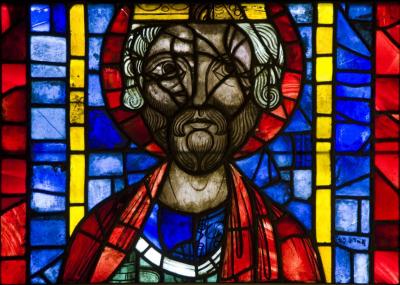
In 2008 Viscount Churchill retired after 20 years as Chairman of Trustees and a new Chairman, Juliet Short, was appointed. In April 2010 the retiring Curator Susan Mathews received an MBE for services to the Arts.
Acquisition highlight: The 13th century Bust of a King (2003.3) panel from Soisson cathedral was acquired for the museum in 2003. Originally from Soissons Cathedral, this medieval panel depicts a crowned figure, probably a royal saint or Old Testament king. It was purchased at auction with the generous assistance of The Art Fund, The V&A Purchase Fund and The Friends of The Stained Glass Museum.
2010s – Celebrating 40 years
In 2012 new temporary exhibition cases and LED panels were installed in the gallery as part of a flexible display project begun under Susan Mathews’ successor, Curator Sarah Roberts and completed by Interim Manager Will Schenck. Jasmine Allen was appointed as Curator in late 2012 and took up post in February 2013.
Various improvements were made to the museum’s collections care thanks to various projects funded by the Association of Independent Museums (AIM). In 2015 new aluminium roller shutters were installed in the museum’s store to keep the reserve collection secure in these working spaces. In 2017 funding was also received from AIM to conserve and reframe the large cartoon by John Piper for a window in St Bartholomew’s Church, Nettlebed, Oxfordshire. Following a public appeal and contributions by AIM, in 2019 the museum’s storage space was extended with the addition of two new glass storage racks to house the museum’s growing stained glass collections.
The museum’s staff team also grew in this decade, and from 2016 the museum appointed its own dedicated part-time Learning Officer. This enabled a significant development in the museum’s learning and engagement programmes for schools and families, and in 2018 a family-friendly area and children’s discovery bags were created for visiting children.
In November 2016 The Stained Glass Museum CIO (1169842) became the governing body of The Stained Glass Museum, and in November 2021 was amalgamated with The Stained Glass Museum Trust (274776).
Collecting in this decade principally focused on 20th and 21st century acquisitions, with windows by the likes of Alfred Pike, Leonard Potter, J.E. Nuttgens, Geoffrey Clarke, Margaret Traherne and Graham Jones added to the collection.
The museum continued to showcase the work of contemporary stained glass artists, and from 2017 began to exhibit panels submitted as part of the annual Stevens’ Architectural Glass Competition organised by the Worshipful Company of Glaziers and Painters of Glass.
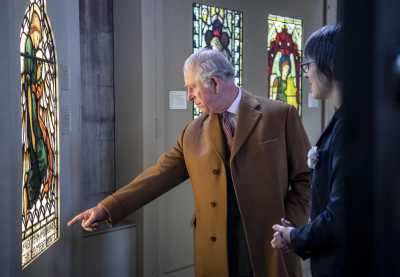
After visiting the museum gallery, His Royal Highness met a group of children from the Lantern Primary School during a glass fusing workshop. His Royal Highness then joined over 200 invited guests at a reception in his honour in the Lady Chapel of Ely Cathedral, where he cut the museum's 40th birthday cake and unveiled a plaque commemorating the visit.
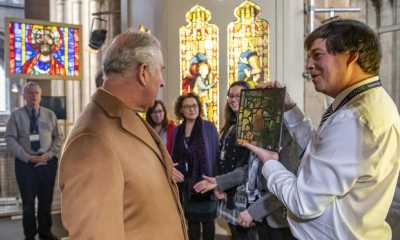
From 2018-20, the museum began looking more seriously at its future development and where geographically that might take us. A two-year project funded by the National Lottery Heritage Fund, ‘Windows onto the Future: investigating options for an accessible and resilient Stained Glass Museum’, 2018-2020, enabled the museum to consider in detail its strategic options for future development. The project explored how the museum can fulfil its vision as a national centre for stained glass in the future both on site and in potential new locations, as well as how to develop digital presence and expand partnerships with the creative sector.
Visitor numbers continued to rise over this decade, reaching 26,000 in 2018-19. The Stained Glass Museum also won an award for its Spotlight and Behind-the-Scenes Tours at the 2019 Museums in Cambridgeshire Awards.
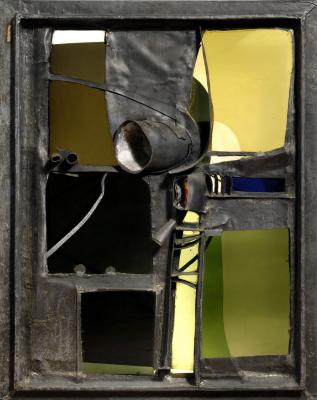
Acquisition highlight: Four artworks by the significant twentieth-century British stained glass artist and sculptor Geoffrey Clarke, RA (b. 1924) (2014.1, 2014.2, 2014.3, 2014.4) were acquired by the museum in 2014. (1) Saint Anthony; (2) Priest; (3) Saint Sebastian (all dated 1949); and (4) Fragment (dated circa 1956-59) are all key examples of Clarke’s early work in stained glass, in abstract and semi-abstract styles, and demonstrate the experimental and sculptural nature of his work.
2020s: Post covid
The early part of the 2020s proved challenging as the covid pandemic saw the museum close its doors to visitors for an extended and unknown length of time. Without its income from admissions, events, workshops, and shop sales the museum’s future was threatened.
Thankfully the museum was successful in applying for emergency grant funding from the Culture Recovery Fund, Arts Council England, The National Lottery Heritage Fund, The Headley Trust, and East Cambridgeshire District Council.
Following a five-month closure period, the museum briefly reopened in the summer of 2020, and after another six months closure over the winter, reopened permanently in May 2021. Staff worked hard to create and manage the necessary safety features to allow the museum to safely reopen. Reopening made the challenges of the museum’s shared entrance and exit via the winding staircase restricted space in the south triforium even more readily apparent. A specially programmed traffic light system was installed on the stairs to prevent visitors from bumping into one another on the stairs, and radio systems were used to create further access controls at busy times.
Upon the museum's first reopening, visitors were treated to a temporary exhibition of eight stained glass panels by Rachel Mulligan, inspired by the rhyme ‘Tinker Tailor Soldier Sailor’ which the artist had reimagined for the covid era. From the thief stealing toilet rolls to a soldier building an NHS Nightingale hospital, the panels were both beautiful and poignant.
During this period the museum took the opportunity to upgrade IT systems, digitise collections and connect with audiences virtually. A new website was launched with a complete and enhanced online collections search, our popular programme of talks moved online and reached a much larger and more international audience than ever before, and we delivered several online learning sessions.
When the museum reopened for a second time in May 2021 visitors enjoyed seeing a newly acquired artwork by Kehinde Wiley on display, which is one of the museum’s largest artworks and the first artwork in the collection by a known black artist.
In March 2022 the museum delivered a successful trial outreach project in Coventry in partnership with local stained glass artist Jamal Rafay and community group Foleshill Creates, a group that brings together people from the Foleshill area through art and creativity, and encourages community cohesion, sharing skills, stories and knowledge. Alongside making their own piece of stained glass, the group collaborated on a stained glass panel inspired by medieval fragments of Coventry Cathedral’s old glass which was then placed on display at Foleshill Library.
In November 2022 the museum launched a curated selection of our stained glass and works on paper to the national Art UK database.
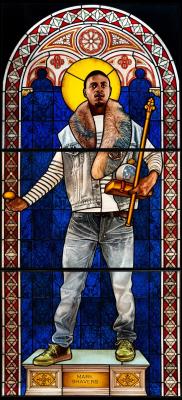
In 2023 the museum launched a new mobile App using Augmented Reality (AR) technology, and new family-friendly dress-up and other interactive activities were added to the museum’s gallery to enhance children and young people’s experiences.
Acquisition highlight: In 2021, as we were finally able to open our doors following the covid lockdowns, we were delighted to do so with the newly acquired St Adelaide by the artist Kehinde Wiley (2021.1). Made in 2017, this panel places a young black man, model Mark Shavers, in the pose of St Adelaide as portrayed in 1843 by French academic painter Jean-Auguste-Dominque Ingres for the Chapel of St Ferdinand, Paris. Wiley plays with ideas and representations of religion, power, gender, and race. The piece was purchased with the generous assistance of The Art Fund, the Arts Council England/V&A Purchase Grant Fund, and SHARE Museums East/Arts Council England Acquisitions Grant, 2021.
Today
Today the museum has an internationally-significant collection of stained glass illustrating the development of the art from the medieval period to the present day. It is the only museum dedicated to stained glass in the UK, and one of a handful of places in the world with such a broad chronological span of stained glass exhibits. Through its collections, educational visits for schools and other groups, diverse series of public events and practical glass workshops for adults and children the museum offers a variety of opportunities for engaging with our stained glass heritage.
Tweets by The Stained Glass Museum, Ely
NEWS
WHAT'S ON
BECOME A FRIEND
DONATE
The Stained Glass Museum is an independent accredited museum and registered charity no. 1169842.

_thumb.jpg)
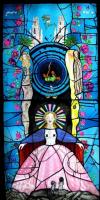
_thumb.jpg)